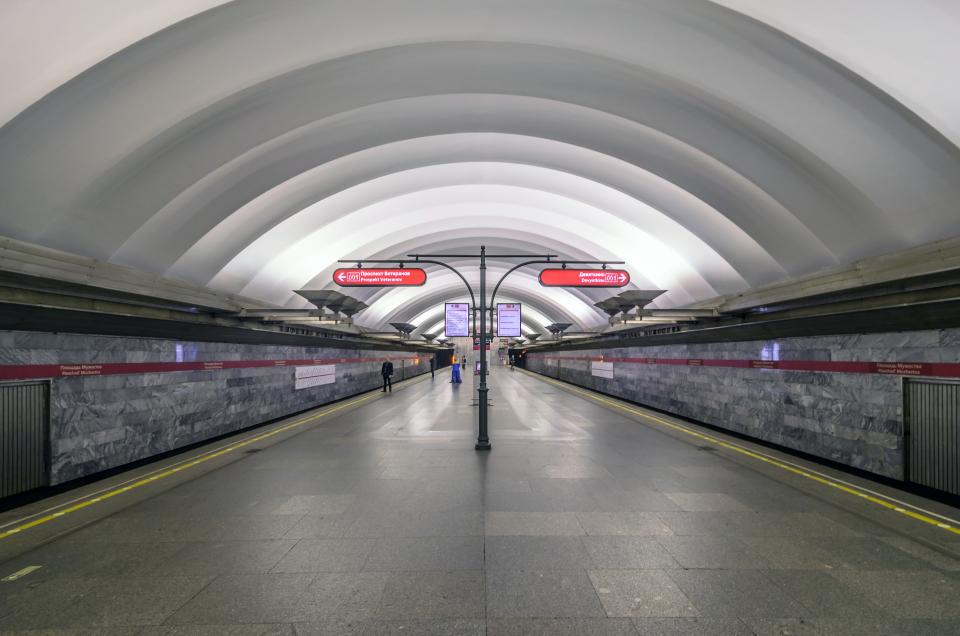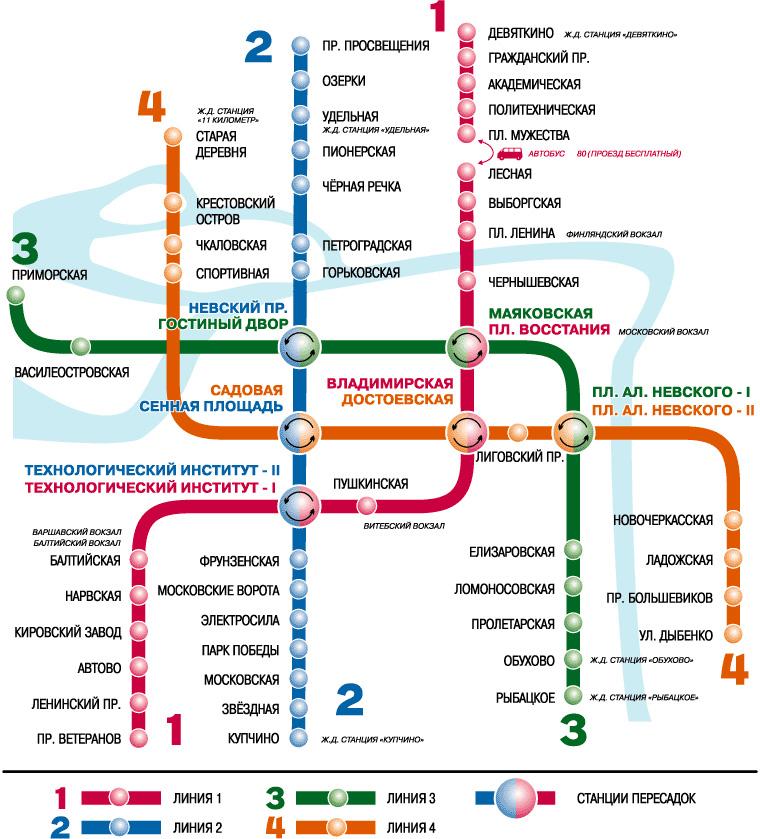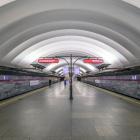The city of Saint Petersburg has a long history of flooding. Since its early times, it had to deal with problems of infections, disease-related casualties, as well as the general flood crisis and the lack of protection against such catastrophes. The so-called razmyv in the Saint Petersburg Metro reveals another (mostly unknown) consequence of such floods. The flood divided the city’s subway system into two parts and separated the northern living quarters from the city center and other transport hubs for nearly 10 years.

Ploshchad Muzhestva station in 2014.
Ploshchad Muzhestva station in 2014.
Photograph by Alex ‘Florstein’ Fedorov, 2014.
Accessed via Wikimedia on 7 October 2019. Click here to view source.
 This work is licensed under a Creative Commons Attribution-ShareAlike 4.0 International License.
This work is licensed under a Creative Commons Attribution-ShareAlike 4.0 International License.
The location of the city of St. Petersburg poses a challenge to the construction of underground structures, which made it difficult to build a metro. This problem became evident in the late nineteenth century, when the first subway system plans evolved. As a result, most stations (the first line opened much later, in 1955) were built at a depth of at least 50 meters or deeper, including the stations Lesnaya and Ploshchad Muzhestva, which opened in 1975 in the northern part of the city center. The problem of underground flooding was an issue that Lenmetrostroi—the institution responsible for planning and building the metro and its tunnels since 1946—had to deal with since the very establishment of the Leningrad Metro. The first problems with underground rivers occurred during the construction of the first line in the 1940–50s.
The same issues occurred during the construction of the tunnels that led away from the city center to the northern part of Saint Petersburg. Already during the construction of the new stations in 1974, metro workers had continued troubles with subterranean water, which flooded more than 400 meters of their ongoing construction. Due to a set of immediate measures, it was possible to save the already constructed tunnels, while special tunnel segments made it possible to run the new stations and connect the developing living quarters basically forming the whole northern part of the metropolis. The development of the transportation network was additionally expanded, and four more stations, Politechnicheskaya, Akademicheskaya and Grazhdanskyj prospect, were opened—most of them in 1975. Later, in 1978, Devyatkino, the last station in the northern part of the city opened. Still, subterranean waters affected the activity along the route between Lesnaya and Ploshchad Muzhestva stations (as well as the end of this line). Trains could not run on some days, because of water dripping into the tunnels. The so-called “abnormal part” remained a constant worry of the metro operators.
In 1995, the situation worsened: between Lesnaya and Ploshchad Muzhestva stations, trains drove through water, which also was “dripping on them, like in a shower.”

Official metro scheme from 2002, showing the “gap” between Lesnaya and Ploshchad Muzhestva stations.
Official metro scheme from 2002, showing the “gap” between Lesnaya and Ploshchad Muzhestva stations.
© Мир метро
Used by permission.
The copyright holder reserves, or holds for their own use, all the rights provided by copyright law, such as distribution, performance, and creation of derivative works.
Finally, on 2 December 1995, it became necessary to close the tunnels and shut down the route as well as all the five connected stations in the northern part of the city. Furthermore, the tunnels had to be flooded completely in order to avoid further damage to the surface of the city. Approximately 500,000 citizens of Saint Petersburg had to find other ways to reach the city center. They either endured long commutes by existing buses, trolleybuses, and trams or use bus lines, established to replace the metro. These new bus lines, however, were not able to cope with the heavy passenger traffic. Likewise, the railway connections between the northern parts of the city and the Finland Railway station were not able to meet the demands of passengers from the northern part of the city. The outgoing metros from Devyatkino to Ploshchad Muzhestva were not sufficient to fix the situation.
Metro operators soon started the discussion of possible measures to fix the tunnels in collaboration with Lenmetrostroi. Although the inability to connect two metro stations caused a critical situation within the city’s infrastructure, it was not possible to solve this problem immediately. Only in 2001 did it become possible to build new tunnels from Lesnaya station to Ploshchad Muzhestva station using another route. Because of financial and political difficulties, residents of the north-eastern area of the city had to wait for nearly 10 years for their metro. After the razmyv, there were multiple rounds of competition for the contract to construct a new tunnel. Local authorities were able to begin the construction in 2001, after they finally established the budget and hired an Italian-Swedish company to build a new connection between the stations. The new tunnels where finished in June 2004. Only recently, the residents of the divided city and regions around the five impacted metro stations were again able to use the metro to reach the city center.
It is, therefore, fair to say that Saint Petersburg’s floods, caused by the geological peculiarities of the local underground, affected not only the “surface” of the city and the transport on the city streets, but also the entire urban infrastructure. The aforementioned story of Lesnaya and Ploshchad Muzhestva stations is not the sole example of this phenomenon. Other stations also struggle with subterranean waters and harsh underground conditions. The Saint Petersburg Metropoliten has to conduct continuous work to deal with these troubles. Issues within infrastructure systems of large cities can become detrimental to their operation. This specific example shows how environmental factors may critically disrupt complex infrastructures, despite being well-known and seemingly considered.
How to cite
Schroeder, Phillip. “Dividing a City: The Flooding of the Saint Petersburg Metro (1995–2004).” Environment & Society Portal, Arcadia (Autumn 2019), no. 43. Rachel Carson Center for Environment and Society. doi.org/10.5282/rcc/8904.
ISSN 2199-3408
Environment & Society Portal, Arcadia
 This work is licensed under a Creative Commons Attribution 4.0 International License.
This work is licensed under a Creative Commons Attribution 4.0 International License.
2019 Phillip Schroeder
This refers only to the text and does not include any image rights.
Please click on the images to view their individual rights status.
- Kulagin, Nikolai. Razmyv: Istoriia preodoleniia. Moscow: TA Engineering, 2005.
- Trefilov, Yurii. Kembriiskii izlom. Metrostroi byl est’ i budet! St. Petersburg: Russkaya kollektsia, 2011.
- Lisovskii, V.S. Leningrad. Raiony novostroek. Leningrad: Lenizdat, 1983.
- Zhdanov, Andrei. Metropoliten Peterburga. Legendy metro, proekty, arkhitektory, khudozhniki i skul'ptory, stantsii, nazemnye vestibiuli. Moscow: Tsentrpoligraf, 2017.








